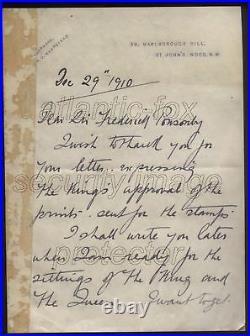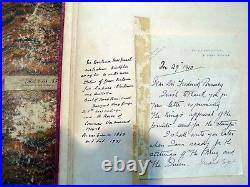



A Fascinating and Unique letter from Australian Sculptor and Medalist Sir Edgar Bertram Mackennal, dated Dec 29th 1910, from 38 Marlborough Hill, ST JOHN’S WOOD. London to the Kings Private Secretary. Dear Sir Frederick Ponsonby, I wish to thank you for your letter expressing the King’s approval of the prints sent for the Stamps. For more from this collection see our shop category for SIR JOHN PONSONBY COLLECTION. John Ponsonby (British Army officer)From Wikipedia, the free encyclopedia. Major-General Sir John Ponsonby KCB CMG DSO (25 March 1866 26 March 1952) was a British Army officer who commanded 5th Division during World War I. Born the son of Sir Henry Ponsonby (Queen Victoria’s Private Secretary), his Mother Hon. Mary Elizabeth Ponsonby, Maid of Honour to Queen Victoria and a daughter of John Crocker Bulteel. His brothers were Frederick Ponsonby, (Assistant Private Secretary to Edward VII & GV), and Arthur Augustus William Harry Ponsonby, 1st Baron Ponsonby of. (British politician, writer, and social activist). Sir John was educated at Eton College, He was gazetted to the Royal Irish Rifles 16 November 1887, and to the Coldstream Guards 15 August 1888, becoming Lieutenant 29 June 1891. He was ADC to the Governor and Commander-in-Chief, South Africa, 10 August 1891 to 30 January 1895; served in operations in Matabeleland (Medal); was promoted to Captain 7 September 1898, and in that year served in Uganda (Medal), and again in 1899, during the operations against Kabarega (clasp). He was Adjutant, 5th New Zealand Regiment, 8 June 1900 to 1 January 1901; afterwards in command 1 January to 18 January 1901. From February to May 1900, be was employed with Mounted Infantry, and he took part in operations in the Transvaal, west of Pretoria, from July to 29 November 1900; operations in the Transvaal, February to June 1901; operations in Cape Colony, February to 31 May 1902. He was mentioned in Despatches [London Gazette, 10 September 1901]; received the Queen’s Medal with four clasps, the King’s Medal with two clasps, and was created a Companion of the Distinguished Service Order [London Gazette, 27 September 1901]: John Ponsonby, Captain, Coldstream Guards. In recognition of services during the operations in South Africa. The Insignia were presented by the King 27 October 1901. He was promoted to Major 23 January 1904, and commanded the Guards’ Depot 1 March 1905 to 28 February 1907. He became Lieutenant Colonel 28 October 1913. Lieutenant Colonel Ponsonby served in the European War, 191418; commanded the 2nd Guards Brigade, BEF, 26 August 1915 to 19 November 1916: was given the Brevet of Colonel 1 January 1916; commanded the Special Reserve Infantry Brigade 28 November 1916 to 7 March 1917; commanded the 21st Infantry Brigade, BEF, 8 March to 20 March 1917; became Colonel 20 March 1917; commanded the 2nd Guards Brigade, British Armies in France, 21 March to 21 August 1917; commanded the 40th Division, British Armies in France, 22 August 1917 to 3 July 1918; subsequently commanded the 5th Division, British Armies in France, 4 July 1918 to 1 April 1919; was promoted to Major General 1 January 1919. He was mentioned in Despatches; created a CMG in 1915, a CB in 1918, and was given the Brevet of Colonel. He went on to become General Officer Commanding 5th Division remaining in that role until the end of the War. After the War he became General Officer Commanding the Madras District of India. He retired in 1928. He lived at Haile Hall near Beckermet in Cumbria Sir Edgar Bertram Mackennal KCVO RA (12 June 1863 10 October 1931), usually known as Bertram Mackennal, was an Australian sculptor and medallist, most famous for designing the coinage and stamps bearing the likeness of George V. He signed his work “BM”. Bertram Mackennal was born in Fitzroy, Victoria, a suburb of Melbourne, the second son of parents who were both of Scottish descent. His mother was Annabella, née Hyde, and his father was John Simpson Mackennal, a sculptor. John Mackennal provided Bertram his early training which was followed by studies at the school of design at the Melbourne National Gallery which he attended from 1878 to 1882. Marshall Wood, a visiting English sculptor, advised him to go Europe and promised employment. Mackennal left for London in 1882 to study at the National Gallery Schools, discovered Wood had died and shared a studio with Charles Douglas Richardson and Tom Roberts. In 1884 he visited Paris for further study and married a fellow student, Agnes Spoone. On returning to England, Mackennal was appointed head of modelling and design at the Coalport Potteries, Shropshire early in 1886. While in Australia, Mackennal obtained other commissions, including the figure over the doorway of Mercantile Chambers, Collins Street, Melbourne. Mackennal also met the visiting Sarah Bernhardt who strongly advised him to leave Australia and return to Paris. La Tete d’une Saint (Head of a Saint) 1892 was produced soon after his arrival in Paris. Head of a Saint features a contemporary modern woman, with elaborate lilies. The marble version of Head of a Saint was included in the Paris Salon of 1892, with a single bronze version known to also exist. In 1892, the Argus reported that the’relief in marble, for its size, is the best thing of its kind in the Salon. In 1893 he had his first success when his full-length figure “Circe”, now at the National Gallery of Victoria, obtained a “mention” at the Old Salon and created a good deal of interest. It was exhibited later at the Royal Academy of Arts where it also aroused great interest, partly because of the prudery of the hanging committee which insisted that the base should be covered. He was the first Australian to exhibit at the Royal Academy. Commissions began flowing in, among them being the figures “Oceana” and “Grief” for the Union Club, Sydney. Two Melbourne commissions brought him to Australia again in 1901: the memorial to Sir William Clarke, 1st Baronet at the Treasury Gardens, Melbourne, and the sculptures for the Springthorpe Memorial in Kew. This dual success brought Mackennal into great prominence, and he was elected an associate of the Royal Academy in 1909, the first Australian accorded this honour. He also designed the medals for the 1908 London Olympic Games. This is certainly his most enduring design. Can be seen on the truncation of the King’s neck on the obverse of all British coins of George V. His next important work was the memorial to Thomas Gainsborough at Sudbury, which was followed by the memorial tomb of King Edward VII at St. George’s Chapel, Windsor. Mackennal also sculpted statues of King Edward VII for London, Melbourne, Calcutta and Adelaide. Mackennal was the first Australian artist to be knighted. He was created a Knight Commander of the Victorian Order in 1921 by H. King George V on the occasion of the unveiling of the London equestrian statue of King Edward VII. He was elected R. Among Mackennal’s later works were the nude male figure for the Eton War Memorial, the Parliamentary War Memorial to the members of both houses of parliament in London, the figures of the soldier and the sailor for the cenotaph in Martin Place, Sydney, the bronze statue of King George V at Old Parliament House, Canberra, and the head of “Victory”, presented to the Commonwealth by the artist, also at Canberra. He completed the Desert Mounted Corps memorial at the Suez Canal from the designs of Charles Web Gilbert a little while before his death. Sir Bertram Mackennal died suddenly from rupture of abdominal aneurysm at his house, Watcombe Hall, near Torquay, Devon on 10 October 1931; he was survived by Lady Mackennal and a daughter. Powered by SixBit’s eCommerce Solution. The item “1910 UNIQUE! Mackennals Letter, GV’s Approval of his design for Postage Stamps” is in sale since Wednesday, July 18, 2018. This item is in the category “Collectables\Autographs\Certified Original Autographs\Historical”. The seller is “atlantic-fox” and is located in Maryport. This item can be shipped worldwide.
- Surname: Mackennal
- Surname Initial: M
- Related Interest: GV Stamps & Coin Design
- Era: GV
- Period: 1910
- Autograph Type: Manuscript Letter
- Famous Persons: Edgar Bertram Mackennal
- Country of Origin: England



